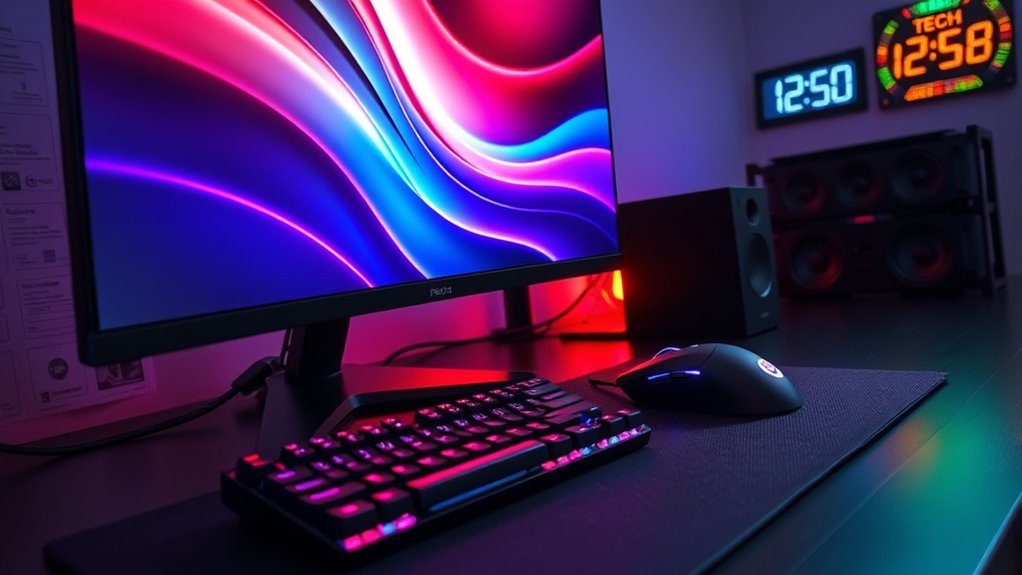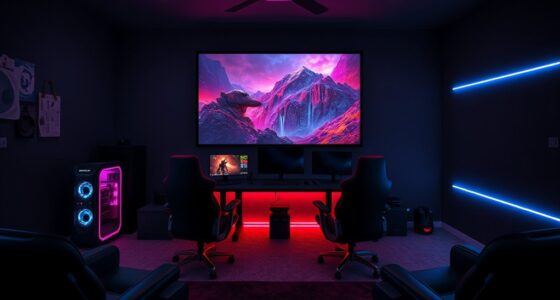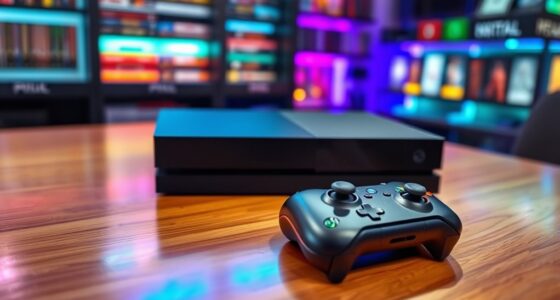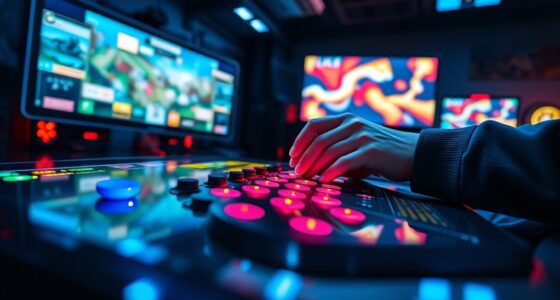Many gamers mistake input lag as just controller delay, but it also includes device and display processing time. Higher refresh rates don’t always mean less lag if your hardware isn’t optimized. Mixing up response time with input lag leads to confusion, and ignoring display or connection settings can increase delays. Not all monitors are equal, and system tweaks make a big difference. Keep exploring to uncover the full picture and improve your gaming responsiveness.
Key Takeaways
- Input lag includes controller latency, device processing, and display response time; it’s not just button press delay.
- Higher display refresh rates improve motion smoothness but don’t automatically reduce input lag.
- Response time measures pixel change speed, which affects image clarity, not input delay.
- Proper calibration of controllers and display settings significantly reduces overall input lag.
- Wired connections and system optimization are essential for minimizing input delay and ensuring responsive gameplay.
Misunderstanding the Definition of Input Lag

Many people wrongly assume that input lag only refers to the delay between pressing a button and seeing the on-screen action. In reality, it’s a broader concept that includes controller latency, which is the time it takes for your input device to register and send signals. Proper input device calibration also plays a vital role; if your controller or mouse isn’t calibrated correctly, it can add unnecessary delay, making your gameplay feel sluggish. This is especially important when considering engine tuning options that can optimize your system’s responsiveness. This means that even if your display has a high refresh rate, poor controller calibration or high controller latency can still cause noticeable lag. Understanding that input lag encompasses these factors helps you identify and fix issues beyond just the display, giving you a more accurate picture of your gaming setup’s performance.
Believing Higher Refresh Rates Always Equal Better Performance
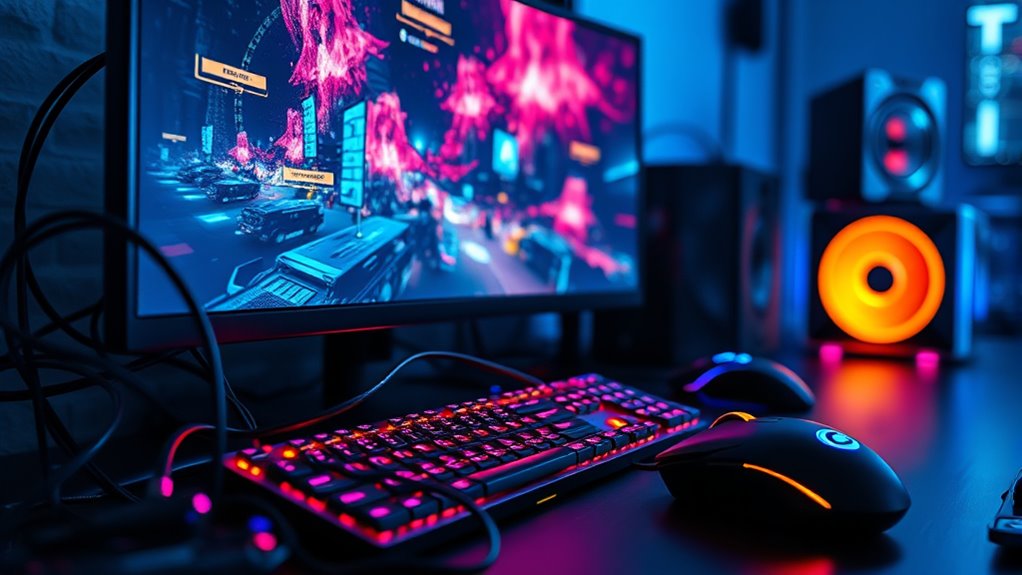
While higher refresh rates can improve the smoothness of your gameplay, they don’t automatically guarantee better performance. Many fall for refresh rate myths, believing that doubling or tripling the refresh rate will always deliver a competitive edge. However, display latency—the time it takes for a display to show a frame—can still affect your experience. A higher refresh rate reduces motion blur but doesn’t necessarily reduce input lag or make your game more responsive if other factors, like your hardware or connection, lag behind. Remember, a 120Hz monitor isn’t inherently better than a 60Hz one if your system struggles to keep up. Focus on overall display latency and system performance instead of just chasing higher refresh rates. Additionally, understanding Bitcoin IRA concepts can help you optimize your investment strategies outside gaming.
Confusing Response Time With Input Lag
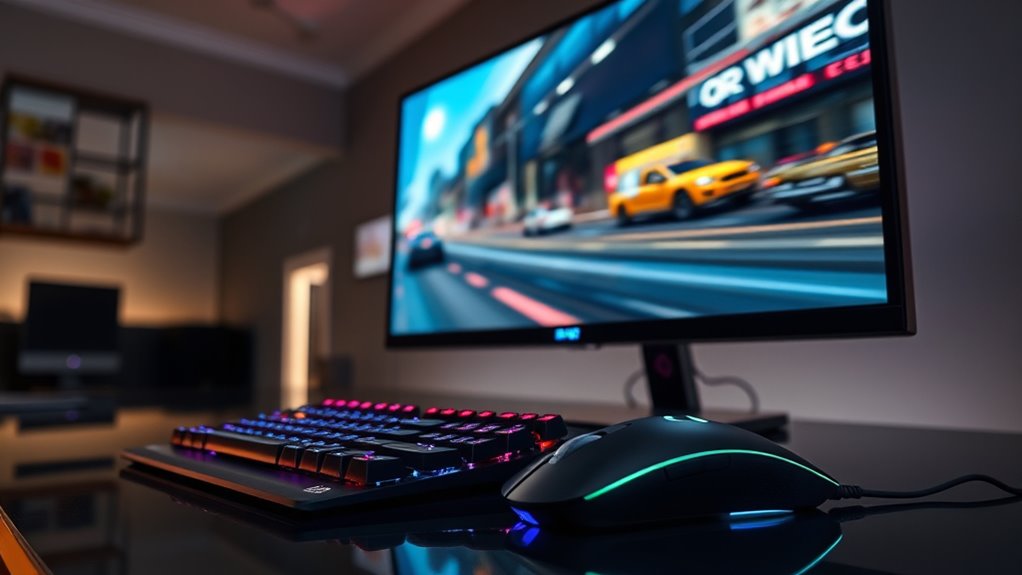
Response time and input lag are often confused, but they refer to different aspects of your gaming display. Response time measures how quickly a pixel changes color, affecting image clarity. In contrast, input lag, or display latency, is the delay between your action and the display’s response. Many believe faster response times mean lower input lag, but that’s not always true. Response time impacts image sharpness, not how fast your commands register. To clarify:
- Response time relates to pixel switching, not input delay
- A fast response time doesn’t guarantee minimal display latency
- High response times can cause motion blur, unrelated to input lag
- Display latency depends on processing, not just response time
- Fostering a digital-friendly environment at home can help optimize gaming setups and improve overall digital literacy.
Understanding this difference helps you optimize your gaming setup effectively.
Overlooking the Impact of Display Settings on Input Delay
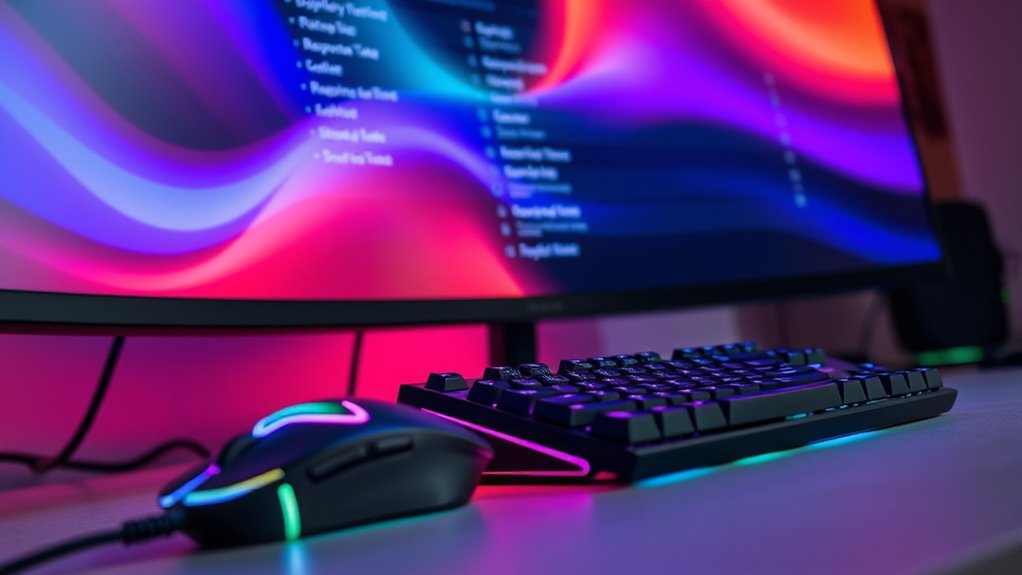
Adjusting your display settings can considerably influence input delay, often more than you might realize. Proper display calibration ensures your monitor is fine-tuned for low latency, reducing unwanted input lag. Many gamers overlook how settings like refresh rate, response time, and color accuracy impact performance. For example, enabling high refresh rates can make your gameplay smoother and more responsive. Additionally, accurate color calibration not only improves visual quality but can also help you spot enemies and details more quickly, indirectly affecting reaction times. Ignoring these adjustments means you might be accepting unnecessary input delay. By fine-tuning your display for ideal performance, you eliminate potential delays caused by poor calibration or subpar color accuracy, giving you a competitive edge and a more immersive gaming experience. Display calibration can significantly improve your overall responsiveness and gameplay precision.
Assuming All Gaming Monitors Are Created Equal
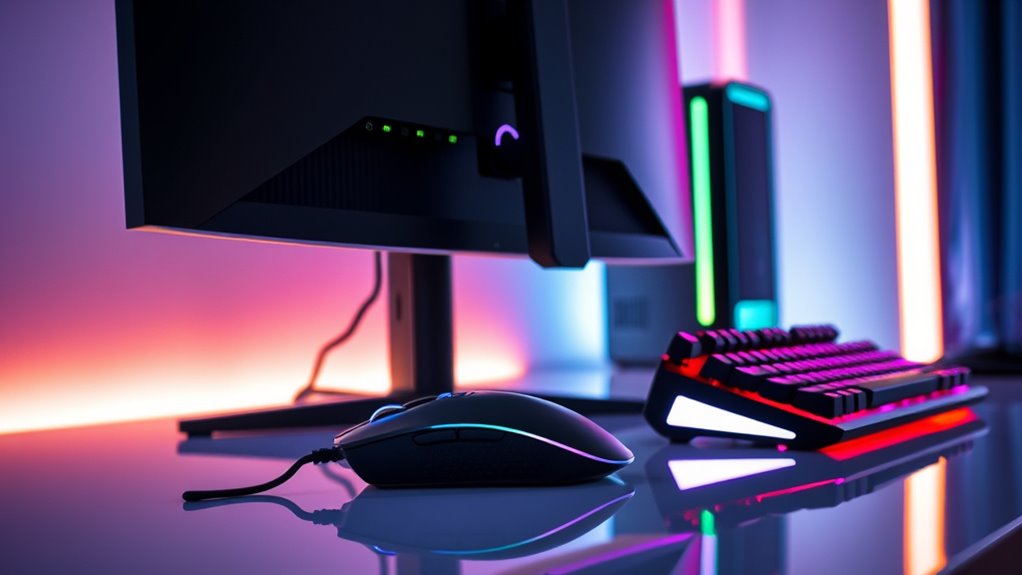
Have you ever assumed that all gaming monitors offer the same performance? Not all monitors are equal, especially when it comes to factors like monitor size and brand reputation. Cheaper or lesser-known brands might save you money but often compromise on features like refresh rate, response time, or input lag. Larger monitor sizes can enhance immersion but may introduce latency issues if not paired with a compatible response time. A reputable brand usually guarantees better build quality, consistent performance, and reliable customer support. Additionally, understanding input lag is crucial because it directly impacts your gaming experience and reaction times.
When choosing a monitor, consider:
- Monitor size suited to your gaming setup
- Brand reputation for quality and support
- Response time and refresh rate
- Features that support low input lag
Assuming all monitors are the same could cost you in gameplay performance.
Ignoring the Role of Connection Types and Cables

Many gamers overlook how connection types and cable quality affect input lag. Choosing wired connections over wireless can reduce latency, and using high-quality cables guarantees a stable signal. Ignoring these factors can lead to unnecessary delays in your gameplay. Additionally, understanding the technology private placement investments landscape can inform better choices for equipment that minimizes lag.
Wired vs. Wireless Connections
While wired connections are often considered more reliable for gaming, wireless setups have improved considerably in recent years, offering greater convenience without necessarily sacrificing performance. Modern wireless connections can deliver low wireless latency and good connection stability, making them suitable for most gaming needs. However, factors like distance, interference, and network congestion can affect performance. To maximize your wireless experience, consider:
- Using a high-quality router with dual-band support
- Keeping your device close to the router
- Minimizing interference from other electronics
- Ensuring your network is not overloaded
- Understanding wireless technology can help you optimize your setup further.
These steps help reduce wireless latency and enhance connection stability, making wireless setups a viable choice for many gamers. Ultimately, your decision depends on your environment, but wireless tech continues to close the gap with wired connections.
Cable Quality Impact
Even if you have a top-tier gaming setup, using low-quality cables can still negatively impact your input lag and overall gaming performance. Cable quality directly affects signal transmission, guaranteeing minimal delay and crisp visuals. Poor-quality cables may introduce interference, signal degradation, or inconsistent data transfer, which can increase input lag and cause display issues. It’s crucial to choose cables that meet current HDMI standards, such as HDMI 2.0 or HDMI 2.1, to guarantee reliable performance and compatibility with high-resolution, high-refresh-rate displays. Cheap or outdated cables might not support the bandwidth required for ideal gaming, leading to increased latency or reduced image quality. Investing in high-quality, certified cables helps ensure your setup performs at its best, providing a smoother, more responsive gaming experience. Additionally, using proper connection types ensures optimal data transfer and minimizes latency.
Underestimating the Importance of System Optimization

You might think system optimization doesn’t make much difference, but it directly impacts your response time and gameplay smoothness. Tuning your hardware and software can reduce lag and improve stability, giving you a competitive edge. Overlooking power supply and network stability can cause unexpected delays, so don’t underestimate their importance. Additionally, understanding AI vulnerabilities can help you better troubleshoot and optimize your gaming setup to prevent potential issues.
Impact on Response Time
System optimization plays a crucial role in response time, yet many gamers underestimate its impact. Poor system settings can increase perceived delay, making gameplay feel sluggish even if hardware is capable. When your system isn’t optimized, visual responsiveness suffers, leading to delayed actions and less accurate control. Small tweaks can markedly reduce input lag and improve your overall experience. Keep in mind:
- Background processes can cause unnecessary lag
- Outdated drivers slow down response
- Incorrect display settings increase perceived delay
- Unoptimized game configurations hinder visual responsiveness
Focusing on system optimization helps ensure your setup is delivering the best possible performance. You’ll notice smoother, more immediate reactions, which can be the difference between winning and losing. Don’t overlook these adjustments—they’re essential for minimizing response time.
Hardware and Software Tuning
Optimizing your hardware and software settings can considerably reduce input lag and improve gaming performance. Start by reducing controller latency through firmware updates and selecting low-latency input devices. Proper input device calibration ensures your controller or mouse is accurately aligned, minimizing delays between your actions and on-screen responses. Adjust your graphics settings to prioritize performance over visual effects, which can lower system load and reduce lag. Keep your drivers and operating system up to date, as updates often include performance improvements. Disable background applications that consume resources or cause interference. Using a dedicated gaming mode or optimizing your system for gaming can further streamline performance. Additionally, understanding the role of display refresh rates can help you choose hardware that minimizes lag and enhances responsiveness. These tweaks may seem minor, but they profoundly impact responsiveness and overall gameplay experience.
Power and Network Stability
Have you ever considered how power fluctuations and unstable internet connections can sabotage your gaming performance? Power fluctuations can cause sudden shutdowns or hardware resets, leading to input lag and gameplay interruptions. Similarly, limited internet bandwidth results in lag spikes, making your experience feel sluggish. To optimize, guarantee your power supply is stable with a surge protector or UPS. Check your internet bandwidth and consider upgrading if your connection is slow or inconsistent. Also, prioritize wired connections over Wi-Fi to reduce latency. Remember:
- Use a surge protector or UPS for consistent power
- Upgrade your internet plan for higher bandwidth
- Switch to wired Ethernet for lower latency
- Close background apps consuming bandwidth
These steps help maintain system stability, minimizing input lag caused by power and network issues.
Frequently Asked Questions
How Does Ambient Lighting Affect Input Lag Perception?
Ambient lighting can influence your perceived delay during gaming. If your room is brightly lit, it might make your screen seem less responsive because your eyes adjust differently, reducing the perceived input lag. Conversely, dim lighting can heighten your awareness of delay, making it seem longer. Adjusting ambient lighting to a comfortable level helps you better perceive and react to in-game actions without overestimating input lag.
Can Software Updates Improve Input Lag Performance?
Yes, software updates can improve input lag performance. By optimizing software, developers enhance hardware compatibility and reduce delays, making your gameplay more responsive. While hardware remains essential, regular firmware and driver updates ensure your system operates efficiently, minimizing lag. You might think hardware alone controls input lag, but software optimization plays a critical role in smoothing out response times, giving you a competitive edge and a more seamless gaming experience.
What Role Does Cpu/Gpu Performance Play in Input Delay?
Your CPU and GPU performance directly impact input delay by affecting processing speed. When these components are underpowered or face hardware bottlenecks, they slow down data processing, increasing processing delay and overall input lag. To minimize delay, ensure your hardware can handle your game’s demands smoothly, reducing bottlenecks and improving responsiveness. Upgrading your CPU or GPU can markedly cut down input delay, making your gameplay more precise and enjoyable.
Are Gaming-Specific Features Like HDR Relevant to Input Lag?
Gaming-specific features like HDR are generally not pertinent to input lag. HDR enhances visual quality by improving color and contrast, but it doesn’t impact the responsiveness of your controls or display delay. Focus on gaming features like low input lag modes or fast response times when choosing a monitor or TV. These features help ensure that what you see on-screen closely matches your inputs, giving you a more responsive gaming experience.
How Do Different Game Genres Impact Acceptable Input Lag Levels?
Different game genres have varying input tolerance levels. For fast-paced genres like first-person shooters or fighting games, you need minimal input lag—ideally under 20 milliseconds—to react quickly. In contrast, slower-paced genres like RPGs or turn-based strategy games can tolerate higher input lag without affecting gameplay. Recognizing your game genre helps you prioritize setups that reduce input lag, ensuring you stay competitive and enjoy smooth gameplay.
Conclusion
Now that you know these common misconceptions, you might think you’re ready to optimize your gaming setup. But here’s the catch—you haven’t uncovered the full story yet. There’s always one more factor that could make or break your experience. Stay tuned, because the real secret to conquering input lag isn’t just what you’ve learned so far. Are you prepared to discover what truly sets top gamers apart? The next step might surprise you.
